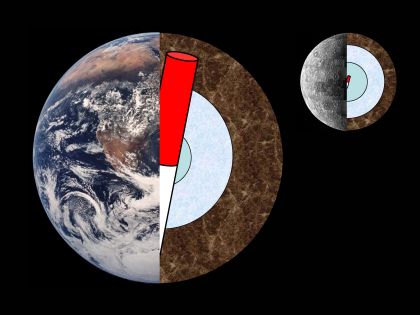Research interests
I am interested in the interior of the various planets in our solar system. I want to understand the difference in their internal structure and in particular the dynamic processes that operate inside the planets. Slow convection in the "solid" rocky mantle of the terrestrial planets gives rise to volcanism that shapes the surface of a planet or that has led to the formation of an atmosphere. Flow in the electrically conducting cores of some planets drives a dynamo process that generates a magnetic field, which shield the atmosphere and the surface of the planet from the energetic particles of the solar wind. Convection inside the giant gas planets is probably the cause for the strong zonal winds that give these planets a banded appearance. Targets of interest are all objects that are large enough to be internally differentiated (e.g. in crust, mantle and core), which includes big satellites and "dwarf planets" such as Vesta. I am also interested in the planetary aspects of our home planet Earth. The overarching aim is to learn what is common and what is different in the various planets and what made Earth special, so that it maintains conditions suitable for life.
In my personal research, I use theory and numerical simulations to understand convection and magnetic field generation in the various kinds of planets. One particular focus is to develop a general theory of planetary magnetism that can explain the differences in strength and geometry of the various planetary fields in terms of differences in size, rotation rate, electrical conductivity and power of convection [more about the geodynamics group]. I am not directly involved in the technical aspects of space experiments, but I am engaged in preparing the scientific exploitation of various experiments. One example is the possible retrieval of tides and librational motion (unevenness of rotation) from data of the ![]() BELA Laser Altimeter on the [Bepi Colombo Mission], which can constrain the size and state of Mercury’s core. Another example is the use of topographic and shape data of Vesta and Ceres to be provided by the [Framing Cameras] on board the
BELA Laser Altimeter on the [Bepi Colombo Mission], which can constrain the size and state of Mercury’s core. Another example is the use of topographic and shape data of Vesta and Ceres to be provided by the [Framing Cameras] on board the ![]() Dawn mission, which allow in conjunction with gravity data to understand the internal structure of these objects. I am involved in the preparation of the deployment of seismometers on Mars by the [Exomars] and perhaps other future missions that will measure the seismic activity of the planet and unravel its interior.
Dawn mission, which allow in conjunction with gravity data to understand the internal structure of these objects. I am involved in the preparation of the deployment of seismometers on Mars by the [Exomars] and perhaps other future missions that will measure the seismic activity of the planet and unravel its interior.
